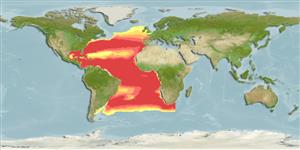Teleostei (teleosts) >
Aulopiformes (Grinners) >
Paralepididae (Barracudinas)
Etymology: Stemonosudis: Greek, stemon, -onos = warp, weft + Latin, sudis = esox, fish of the Rhine, cited by Plinius 9.15; it also means "stake" (Ref. 45335).
Environment: milieu / climate zone / depth range / distribution range
Ecology
Marine; bathypelagic; depth range 50 - 1000 m (Ref. 4473), usually 100 - 800 m (Ref. 47377). Deep-water
Atlantic Ocean: in tropical and subtropical waters. USA to southern Brazil (Ref. 47377).
Size / Weight / Age
Maturity: Lm ? range ? - ? cm
Max length : 15.2 cm SL male/unsexed; (Ref. 4473)
The young occur near the surface, adults up to 800 m and more.
Life cycle and mating behavior
Maturities | Reproduction | Spawnings | Egg(s) | Fecundities | Larvae
Post, A., 1990. Paralepididae. p. 373-384. In J.C. Quero, J.C. Hureau, C. Karrer, A. Post and L. Saldanha (eds.) Check-list of the fishes of the eastern tropical Atlantic (CLOFETA). JNICT, Lisbon; SEI, Paris; and UNESCO, Paris. Vol. 1. (Ref. 4473)
IUCN Red List Status (Ref. 130435)
Threat to humans
Harmless
Human uses
Tools
Special reports
Download XML
Internet sources
Estimates based on models
Preferred temperature (Ref.
123201): 6.2 - 22, mean 13 °C (based on 424 cells).
Phylogenetic diversity index (Ref.
82804): PD
50 = 0.5005 [Uniqueness, from 0.5 = low to 2.0 = high].
Bayesian length-weight: a=0.00245 (0.00104 - 0.00581), b=3.15 (2.94 - 3.36), in cm total length, based on LWR estimates for this species & (Sub)family-body (Ref.
93245).
Trophic level (Ref.
69278): 3.7 ±0.6 se; based on size and trophs of closest relatives
Resilience (Ref.
120179): Medium, minimum population doubling time 1.4 - 4.4 years (Assuming tmax>3).
Fishing Vulnerability (Ref.
59153): Low vulnerability (10 of 100).
